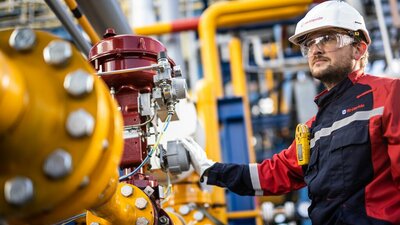Taking to the skies, powered by hydrogen
Published on October 19, 2023
6 minutes

Hydrogen will be a major lever for the decarbonization of air transport, which is committed to achieving net zero emissions by 2050. It's a major challenge, and one that requires us to rethink the way airports are organized today, in particular to integrate the liquid hydrogen supply chain. Interview with Pierre Hamelin, Vice-President Partnerships Operations for Air Liquide’s Hydrogen Energy business line.
In October 2022, the 193 member states of the International Civil Aviation Organization (ICAO) voted in favor of a “net-zero CO2” target for 2050. Although air transport now accounts for only around 2% of global CO2 emissions2, it remains difficult to decarbonize.
Aircraft have a number of specific requirements: energy intensity (especially during take-off), long range, and limited on-board volume and weight. Until now, fossil kerosene has met these needs, especially as its cost remains competitive. However, as energy transition becomes inevitable, alternatives must be found.
That’s right. Aviation’s decarbonization roadmap is largely based on alternative fuels, but also includes improvements to operations and equipment, as well as offsetting measures (certificates). There are a lot of discussions about biofuels and e-fuels, but to achieve the net zero objective sought by the sector, low-carbon and renewable hydrogen will be essential.
As far as biofuels are concerned, there will be limited availability of biomass to meet the growing needs of the different sectors, including mobility. As for e-fuels, their composition requires large quantities of hydrogen and involves interaction with carbon dioxide (CO2), the origin of which will also be scrutinized. Ultimately, the scarcity of one and the cost of the other means that these alternatives are best suited to long-haul flights, while renewable hydrogen is best suited to short and medium-haul flights.
These solutions are complementary, and whatever happens, the energy transition will involve massive investment for the sector.
It’s essentially a question of energy density. Hydrogen in its liquid state is 800 times denser than hydrogen gas. This makes its use imperative to comply with the on-board volume requirements of any aircraft.
It’s also a no-brainer from a logistical point of view: a single truck carrying up to 4 tons of liquid hydrogen is equivalent to 16 trucks loaded with hydrogen compressed to 200 bar! Last but not least, liquid hydrogen can be refueled in a very short time. Aircraft grounding is a key factor for airlines. We are already working with industry players to achieve the 15-minute target for an aircraft requiring 3.5 tons of liquid hydrogen.
I would like to highlight a major breakthrough that took place in September 2023: the start-up H2FLY, in partnership with Air Liquide, successfully completed the world’s first piloted flight of a four-seat aircraft with an electric propulsion system powered by a fuel cell and a liquid hydrogen tank. This included all the functions required for commercial flight (filling, heat recovery, pressure regulation, transient mode, etc.). This experience can be replicated, scaled up and definitively shared within the aerospace industry to accelerate the advent of hydrogen-powered aviation.

“Aircraft have a number of specific requirements: energy intensity (especially during take-off), long range, and limited on-board volume and weight.
”
Pierre Hamelin
Vice-President Partnerships Operations for Air Liquide’s Hydrogen Energy business line
Through its ZEROe program, Airbus has announced its goal of bringing a hydrogen-powered production aircraft to market in 2035. At the end of 2022, the aircraft manufacturer presented a prototype turboprop system equipped with a fuel cell.
At the same time, engine manufacturers like Rolls-Royce are communicating about their advances in direct combustion. I would add that other smaller players have already successfully experimented with hydrogen-powered flights and are aiming for the first commercial flights before the end of the decade.
Things will happen gradually. Until 2030, we’ll be in a demonstration phase with various initiatives, whether driven by start-ups, airports or local authorities. A recent roadmap from the International Air Transport Association (IATA), representing 300 airlines worldwide, confirmed the goal of seeing the first regional flights powered by hydrogen before 2030. After that, short-haul flights (less than 2,000 km) will develop. Finally, 200-seat aircraft with a range of 4,000 km are due to enter service around 2040. I would like to point out that other sustainable aviation fuels will continue to be preferred for very long-distance flights, in the interests of complementarity.
Initially, liquid hydrogen will be delivered by truck, but as demand grows, hydrogen storage and liquefaction can be carried out at airports. In the mature phase, we plan to enable certain airports to produce hydrogen directly on site, using electrolysis in particular.
Hydrogen Airport is an engineering company dedicated to helping airports in their transition to hydrogen. We have identified around 200 airports of interest, both regional and international. Air Liquide brings its knowledge of the full hydrogen value chain and Groupe ADP3 its expertise in airport construction and operations. Armed with these complementary skills, the idea is to move forward step by step to set up a new sector.
For the time being, Hydrogen Airport’s offer consists of tailor-made feasibility studies for airports, including assessment of hydrogen needs, supply chain modeling according to each airport’s situation, management of land implications and cost estimates. Another example: safety protocols for the use of hydrogen do not yet exist at airports. These will have to be established. Airports are, by their very nature, highly constrained environments, and each has its own particularities, whether in terms of location, destinations served, etc. The challenges are many, but they promise to be exciting.
Absolutely. Things are falling into place and the potential is immense. In a preliminary study carried out in 2021 with Airbus and Groupe ADP, we modeled the hydrogen needs of Paris-Charles de Gaulle airport in 2060. In an upper projection, 600 daily flights could require 700 tons of liquid hydrogen. With these volumes and the implied infrastructures, airports could become veritable energy hubs in their geographies.






